Travel:Monterrey-Monarch Mt. & San Pedro, Mexico. Dec. 18-23/2024
- Lili Naveh
- Dec 23, 2024
- 17 min read
Updated: Feb 14
This post is dedicated to our wonderful In-laws - Ora & David who hosted us
UBER pick-up prices were much higher on the early morning of our departure, so we resorted to a regular Taxi company The local taxi driver who showed up in a black Lincoln Town Car, to pick us up to the airport, told us that the ride's lower price he had quoted us pertained to Oakland airport ride and not to SFO the airport, for which we ordered the ride .. ..After a few irritating exchanges, we continued with him to the SFO airport as not to miss our flight.

Several morning flights were cancelled that Dec. 18th morning, due to heavy fog which blanketed the entire bay area, Luckily our direct flight from SFO to Monterrey Mexico departed and landed three and a half hours, later on time.
We finally payed an over-due visit, for the first time, to our wonderful in-laws (the parents of our younger daughter's husband) whom we know at least 15 years since the children wed, at their home town in Mexico

Heavy and slow traffic, congested the HWY, that early evening, along a wide dry River route, and all the way, for the hour long drive, from General Mariano Escobedo International Airport, at, Apodaca, Nuevo León, (MTY) state, which serves Greater Monterrey, and until reaching the hotel we stayed in.
Cosmopolitan and competitive Monterrey with its metro-population of about 5
millions, is considered a Beta World City, is Mexico’s third-largest city, second-largest industrial center and número uno in per-capita income.
.

Monterrey is one of the most developed cities in Mexico, as well as is rich in history,
This economic powerhouse center is known for its strong entrepreneurial ethos, vibrant cultural scene, urban hipster nightlife. and great universities
The Monterrey Institute of Technology and Higher Education (1943) is one of Mexico’s largest educational institutions. Furthermore, the city is also the site of Nuevo León University (1933), Labastida University (1947), the Regiomontana University (1969), and the University of Monterrey (1969).
Monterrey is the heart of one the country’s largest urban agglomerations. with a mixture of services and manufacturing, It is positions on main highways, railroads, and air routes at an elevation of about 538 m in the west-central part of the state, being. the capital of Nuevo León in northeastern Mexico.

Nestled beneath the mountains of the northern Mexican desert, on the foothills of the Sierra Madre Oriental mountain range. Monterrey, city, sprawls over the semiarid floodplain and along the wide mostly dry Santa Catarina River, which spills eastward from the flanks of the Sierra Madre Oriental It is dry most of the year on the surface, but with flowing underground water it bisects Monterrey from east to west, and into north and south halves, and drains the city to the San Juan River and Rio Grande.

The sprawling business and industrial center of Monterrey are fringed by steep pointy mountains. Parts of the city are set against the scenic backdrop of Mount Silla, which rises above the plain to an elevation of more than 1,700 m
Cerro de la Silla (Saddle Mountain) dominates the view at the east of the city and is considered a major symbol of the city
Monterrey was founded as a Spanish settlement in 1596, by Diego de Montemayor
and grew slowly, owing it to Indian resistance, periodic floods, and a lack of mineral wealth.
Many of the first settlers in Monterrey were of Jewish descend. Infect the founding of Nuevo León state. and the surrounding region is linked to Judaism which may have shaped much of the area's identity and customs. .(see more below).
The city is named after Gaspar de Zúñiga, 5th Count of Monterrey, who was viceroy of New Spain from 1595 to 1603. His family originated in Monterrei, Galicia, Spain
By 1775 it had only a few hundred residents, During the Mexican-American War (1846–48) it was captured by U.S. troops, many of whom ravaged the city before order was restored. After the Mexican Independence War, the city mushroomed in the 19th c
into a major population and a key economic center, for the newly formed nation.
When Monterrey was linked by rail with Laredo, Texas .it attracted large-scale foreign investment after 1882, which benefited the industry
In spite of a devastating flood in 1909, the city continued to develop rapidly, particularly after the Inter-American Highway had begun in 1930.
The manufacturing industry has made this one of the most important cities in Mexico, behind Mexico City and Guadalajara.
Its wide range of light manufactures include: woolen textiles, beer, flour. processed foods, chemicals, and glass and plastic products.

A steel-producing company that accelerated the already fast industrialization of the city was founded in 1900 and became one of the world's biggest.

By the turn of the century, thousands of workers of the Heavy industries were producing iron, brass, steel, wagons, Iron-works and steelworks , manufacturing steel sheet-rolls and an array of other metal products

Horno 3. - Oven # 3 at Parque Fundidora
Blast Furnace No 3 is located in what once were the industrial grounds of the Monterrey Foundry, the first steel and iron foundry in Latin America, and, for many years, the most important one in the region
The steel foundry company was of great importance to the economic development of the city during the 20th
After its bankruptcy in 1986, Federal and State government decided to use the land to create a public park which opened in 2001, with the aim to preserve that industry's history as well as being a center of culture, business, entertainment and ecological awareness for the people of the city

A Visit to the Foundry Museum, is definitely worth while
The preservation of historically important buildings and machinery within the Foundry and the dismantling of the others, followed by the construction of the CINTERMEX includes convention center, amusement park, children library, hotel and a cinematheque.

Ora and I paid a visit to the Foundry and the delightful park, along with many locals, who enjoy frequenting it especially on weekends.
Daring to take the old elevator to the top of the huge elaborated steel structure, also gave the opportunity for a panoramic view of the city

Next to the Foundry park is the location the Auditorio Citibanamex- an inddoor amphitheater primarily used for concerts, shows and indoor sports like indoor soccer or basketball
Paseo Santa Lucía


In 2010 the Paseo Santa Lucia was also developed and inaugurated in 2007, inspired by the River Walk in San Antonio , Texas It consists of a 2.5 km artificial Canal alongside a pedestrian path , connecting the Macroplaza and Fundidora Park ,
The project is the longest artificial river in Latin America , and is considered one of the 13 wonders of Mexico created by man.
Xmas Tree made out of colorful plastic baskets decorating the Museum Plaza

The canal is completely navigable via small boats that are taken at the beginning of the walk next to the Museum of Mexican History and the Museum of the Northeast .
We visited the museums which showcase an impressive fossils collection, and historical artifacts
The Canal commemorates the ancient Santa Lucía spring , the site of the third and final founding of Monterrey by Don Diego de Montemayor . The layout of the promenade partly follows that of the spring, which today flows underground, and the canal is partially fed by it. It is the preferred place for by the locals to stroll in the afternoons and on weekends, as well as a world tourist destination.
Varied Urban Landscape

The varied urban landscape— consists of colorful "Favelas" slums, disorderly rolling down off the mountainside, and a mix of fashionable districts, with modern skyscrapers, shopping malls, golf courses, and convention centers, sometimes in close proximity—revealing Monterrey’s blend of wealthy, middle-class, and poor residents.

Clearly its general urban development contrasts strongly with the relative poverty of smaller cities and rural districts.
Beautiful Architecture at Towns' Center
Monterrey Casino
The French neo-classical Casino building served as an important meeting place and cultural center back when it was first built in 1866, but was redesigned in 1922 because the original construction was scorched by the flames during a fire in 1914.

an association football stadium in Guadalupe, Greater Monterrey, Nuevo León, Nicknamed "El Gigante de Acero" in Spanish. "The Steel Giant"inaugurated in 2015, at a cost of US$200 million, and with a capacity of 51,000 people, making it the fourth largest in Mexico.

Little further on the piedmont outskirts to the north and east of the city, irrigated crops are grown, including cotton, citrus fruits, sugarcane, cereals (especially corn [maize] and wheat), and vegetables
Urban Scenes

It was alarming when I saw for the first time,Mexican police and military ride and patroling the streets of Monterrey in back of pick up trucks, pointing scary automatic mchin guns on alert
The presence of the military in public areas and on the streets in Mexico is primarily a response to ongoing issues related to drug trafficking, organized crime, and violence.

On the other hand, Monterrey is very soothing with its festively decorated ornoments and excessive Xmas lighten up , The city looks especially dazzling during this Holiday time of the year, with Santa circulating and greeting the by-passers on his motorbike, throughout the historic center of town

City Center


High-rise hotels, office buildings and many shopping malls mark the central business district, above which looms the lava-red Lighthouse of Commerce, a 70m tall observation tower the
It was designed by the accomplished Mexican architect Luis Barragán and constructed in 1984 by architect Raúl Ferrera .
It beams green lasers into the sky symbolizing the economic aspirations of the city.

Torres Obispado the tallest Skyscraper in Mexico and Latin America - 305 m and 62 floors,
Part of a complex of two skyscrapers, it was completed in 2020.
The tallest building in the complex, called T.Op Torre 1, and houses offices, a Hilton Garden Inn,
commercial space office and restaurants space, .
The smaller, 156-metre, 42-storey tower is designed for residential use only.
Both structures have a 12-storey car park.

Also known as La Gran Plaza - the town's main square built in the early 1980s is located in the heart of the city, and is delightful to visit

The Palacio de Gobierno,
A vast green area of connected squares is home to the city Gov buildings,
The most imposing is the State of Nuevo León Government building,
This Spanish colonial neoclassical style municipal building built in 1908 of pink stone quarried from around San Luis Potosí, is ornate, columned with stained-glass windows & colorful illuminations at night.
On the day we visited guided by Ora, it was lavishly decorated with Xmas ornoments


Fuente de la Vida - Fountain of Life
A modern centerpiece landmark at the square's passage is the majestic Neptune's Fountain formed of 8 bronze figures guided by God Neptune.

The Fountain commemorates the completion of the 520 km aqueduct which comes from the Water Dam Cerro Prieto. most important project for the transmission of drinking water through a transfer from one basin to another,

Additional landmarks at the plaza is Teatro La Ciudad
This cultural space designed by architect Óscar Bulnes in 1984 is located in the heart of Monterrey, and is the largest stage complex in the state, with an area of 9,500 square m
With more than 30 years of operation, it has hosted important music, dance opera, children's shows, cinema, conferences,and theater festivals.
Monuments on the plaza passages


On the north end of the Macroplaza.the striking Museo de Arte Contemporáneo abbreviated as MARCO, This major contemporary art museum, organizes major exhibitions with regional and international contemporary artists.
It was designed by Mexican architect Ricardo Legorreta, in a Minimalist Post-modern architectural style opened in 1991
The bird in the front is called "La Paloma" by sculptor Juan Soriano.

Next to the MARCO museum looms the metropolitan main Cathedral - the Immaculate Conception of Monterrey
the main Catholic church and home of the Archdiocese of Monterrey.
The 18th c, notable cathedral features both neoclassical & baroque architecture. .The building has a central nave in the shape of a Latin cross flanked by niches chapels

It’s overlooked by the Palacio del Obispado, a storied Baroque palace with a regional museum.
Built in the late 1780s, on a hill , the Bishropic Palace was erected on the eponymous Cerro del Obispado to house the seat of religious authority in the Spanish Viceroyalty
The palace was expropriated and work began to turn it into the Regional Museum of Nuevo León in 1902.
The Historic City Center Heart - Pedestrian Shopping St. - José María Morelos

Barrio Antiguo, of the historic quarter, located next to the Government Palace and the Macroplaza, dates from the very founding of the city at the end of the 16th c, It is characterized by its charming cobblestone alleyways and vibrant colonial architecture The buildings preserved today however date mostly from the 18thc onward.

It used to be the commercial and cultural center of the city until the 20C, but now a days
the area boasts a lively nightlife with upscale beer bars, late-night electronic dance clubs, and live music venues showcasing both international and regional bands. Galleries feature local artists' handicrafts, and antiques.

The market on José María Morelos #837- situated in a modern building in the midst of the historic quarter, features rooftop terrace, eateries & shops with gourmet foods, antiques & crafts.
Cool Street Art at the Bario Antigo




One charming restaurant we samples at the Bario Antigo was
Diego DeMontemayor 115 Monterrey. Tel 8120170000
Av. Ignacio Morones Prieto 2414, Sertoma, 64718 Monterrey,
San Pedro Garza García -Suburb

a 10 km Hill, , South of the Santa Catarina River—separates Monterrey from the suburb of San Pedro Garza García. The hill is a spur of the Sierra Madre Oriental and is made up of a series of elevations.
A strange huge mural graffiti of 3 "Guardians" by the contemporary Mexican artists
Ruben Carrasco decorates the entrance wall to the tunnel, connecting the 2 towns

In 1998, the Loma Larga Tunnel - a set of two parallel tunnels, 531.95 m long, was built through the Cerro de la Loma Larga , connecting the municipalities of Monterrey and San Pedro Garza García,
The 2 municipalities are also connected by these 2 bridges
Papal Bridge -El Puente del Papa, Puente de la Unidad -Bridge of Unity
The bridges over the Santa Catarina River connecting San Pedro to Monterrey
San Pedro which is situated in a valley surrounded by mountains, most notably La Loma Larga and Sierra Madre Oriental, was founded in 1596 as the "Hacienda de San Pedro los Nogales" by Diego de Montemayor. Initially it was a rural village south of Monterrey, a land of large plantation, producing crops like corn, wheat, and beans.
.It remained as such until 1940, when the first urbanization in the village started.


Now a days the town is a contemporary, very modern commercial and upscale suburb, popular destination for expats, with an exclusive and international community vibe. It's also considered one of the wealthiest neighborhoods in Latin America, offering a very high quality of life for its rich conservative community of about 135,000.with an average household income of around $1 million per year.
The town hosts the head offices of companies like ALFA, Cemex, Gamesa, Vitro, Pyosa, Softtek and Cydsa.
It is dotted with luxury shopping malls, expensive private membership clubs large green areas, parks, many cafes, excellent restaurants as well as important colleges, universities and hospitals

The town is a host to the Catholic university, Universidad de Monterrey (UDEM), the Instituto Tecnológico de Estudios Superiores de Monterrey (ITESM) 2 of its graduate schools, The Escuela de Graduados en Administración y Dirección de Empresas (EGADE), ITESM's Graduate School of Business, and the Escuela de Graduados en Administración y Política Pública (EGAP),
As well as to the Graduate School of Politics and Public Administration. Both campuses are located in Valle Oriente. There are no public universities in San Pedro
The dramatic mountainous landscape of neighboring San Pedro National Park Reserve offers greener, cooler and cleaner air, Thus, attractive upscale residential gated communities, of tall high rise buildings and luxurious villas have mushroomed on the verdant steep slopes.

Our darling In-laws, who so lovingly hosted us. reside in a gorgeous such an apartment , atop of Chipinque mountain, (part of the Sierra Madre Oriental range) next to the park, from which the unfolding views of the urban valley below are stunning.
The Mt. summit reaches 2,229 m above sea level
The mountain is a symbol for the Monterrey metropolitan area

This stunning mountainside reserve, which conserves the flora and fauna biodiversity of the area covers altitudes from 730 to 2,200 m, and is just 12km from downtown Monterrey.

The Park offers great hiking and mountain-biking on over 60km of well-marked trails, wonderful vistas of Monterrey below, and a sanctuary to spectacular Monarch butterflies which migrate to overwinter between November and March,
San Pedro City Parks visited with our gracious hosts

Thanks to the dedication of San Pedro's Mayor Mauricio Fernandez, elected now for the 4th time,and who has transformed the towns landscape,during a span of 30 years, this area which was once a neglected dump along a water stream
is now an attractive park surrounded by abundant green vegetation, walkways running tracks, dog trails and dog park.
Fernandez is a politician, former senator, businessman and an arts and crafts collector, directly related to the Fernández Ruiloba wealthy and prominent family; owners of PYOSA (Pigmentos Y Oxidos SA).
He also erected a museum in the park to which he donated his personal art.
La Milarca Museum opened last year
Situated inside the Rufino Tamayo Park
Eugenio Garza Lagüera 400, Zona Valle Oriente

The museum which opened only about a year and a half ago (2022) is located in one of the most exclusive areas of San Pedro. It is small and amazing.
La Milarca Museum stands out as a cultural space, for rich Mexican history and contemporary art in its various forms offering a unique experience.
Fransisco Zuniga - 3 Generations
The Costarican-born Mexican artist, known both for his paintings and his sculptures
The multi-millionaire Fernandez built a replica of his northern Mexico mansion to serve as a museum for his art collection, as he wanted to give the public access to his collections of art, The guesstimated cost value at $120 million, was criticized because it is funded in large part with public money. The local government has said the cost of the project was $9.7 million, of which 60% of the funding was public. Fernández Garza said he would put up $984,000. Other private donations are expected make up the difference.
The Museum's Fossil Collection
San Pedro Neighborhoods

Colonia del Valle Neighborhood
In 1940, Alberto Santos- a Mexican businessman and politician, acquired 470 hectares in the area and started an urbanization process of what would become in 1946 the Colonia del Valle in which large lots with beautiful residential private villas , private schools and churches were built also by various European , mainly Spanish and German.
enclaves.

are 3-laned intersecting gardened boulevards that serves the main avenues of the affluent Colonia del Valle neighborhood.
The expended cultivated boulevard and gardened walkway in its middle, which is used for exercising, and strolling..,were also a projected initiated by the current Fernandez Mayor

On Sundays the pedestrian area fills up with many trinkets stalls and stands of street food which Ora took us to sample with many other locals.
Parades usually take place there during Easter and Christmas through the Cazadan
Exclusive shops, apartment buildings, and business offices are located throughout the avenues.
Tikal - Arts &Crafts Store

For an upscale Mexican art &Craft,
a wonderful store located in an old villa
offers an amazing inventory of fabulous
arts and crafts from all around the country
TIKAL. is run by Alicia Menchac.
+52 81 8335 1740. 81 8335 5435 +52 81 8287 4743
Missouri 316 pte. Col del Valle,
San Pedro Garza Garcia. N.L

Arboleda Neighborhood
Located in the heart of San Pedro, Arboleda is most recent modern upscale master-planned community. The high-end mixed-use complex includes multifamily residential towers and villas, commercial office spaces, a luxury hotel, retail areas, restaurants, parks, a club house and a wellness center
Much was designed by KMD architects

is one of the largest shopping malls in Mexico, founded in 1988, and the largest located in the metropolitan.
That was where also the high-rise
hotel we stayed in is located
Av. Diego Rivera 2492, Valle Oriente,
Across from it is located the more traditional SAFI Hotel
The Camino Hotel is less remarkable but has a large pool. The Safi's Lobby has more charm, but the rooms are not that great, and it d it does'nt have a pool

Further up on Av Diego Rivera is the
Quinta Real - a colonial style hotel most upscale of the Camino Real chain hotels,
It is highly recommended for its ambiance ,luxury rooms and beautiful decor, like the colorful painted ceiling in its lobby.

On our last visit day and just 2 hours prior to departing to the airport, for our flight back to CA, we stepped into the
Quinta Real hotel, and were smitten by a fantasy naive style painting hung on the Lobby's hotel, and being offered for sale by a local gallery.
Although we inquired about the painter and requested to contact the gallery, even leaving our contact info, with the hotel staff, hoping to be contacted, strangely no one responded.
Luckily resourceful Ora found the painter's contact via her Facebook, so here is more info and a taste of the artist special style

is an accomplished Peruvian born artist who has been showcasing his work over Latin America and often in many Mexican venues and galleries. We had several contacts with him via the translation help of his English-speaking son.
Roberto can be reached:
Tel/Whats-app +51 949 925 103

La Comunidad Israelita de Monterrey, the Jewish community of Monterrey,
The current community in the area of approximately 500 Jews has existed for over seventy years. In a city with a population of over three million.
Current estimates say about 40,000 Jewish people live in Mexico. Over 95 % of them are living in the capital city, but the origins of this community date back over 500 years to Northern Mexico.
M of the first settlers in Monterrey were of Jewish decent. The story on the prominent Garza family in Monterrey that has long claimed to be descended from Jews. is noted in this book .Ancestors of the Garzas were burned at the stake by the Inquisition in the 1526 auto-de-fe held in the Canary Islands.

The first of those involved was Alberto Canto, (1547 - 1611) a Sephardic Jew who also founded the city of Saltillo and served as the first founder and Mayor of Monterrey, when initially the city was named Villa de Santa Lucía.
Del Canto had been a lover to Montemayor's wife. Montemayor had killed his wife with his sword upon learning of the affair and vowed to kill del Canto
Del Canto escaped and later was arrested on charges of Judaizing, However he escaped and lived among the Indians until the charges were dropped. The founding of Nuevo León linked to Judaism would not end with him.
Crypto-Jews are descendants of Medieval Sephardic Jews who were expelled from Spain and Portugal after the 1492 Edict of Expulsion.
They practiced their Jewish faith in secret, while publicly identifying themselves as Catholic. Many of them fled to New Spain, now Mexico, in 1519, in search of an easier life away from the crown.
The Conversos fled to safer havens in the Ottoman Empire, North Africa, Europe, and the New World. One of those temporary safe havens was el reino de Nuevo Leon (the kingdom of Nuevo Leon) in the northern part of New Spain (Mexico), of which Monterrey was to be its capital.

The first governor of this kingdom who left Spain back then. in 1573 was the Spanish Conquistador, Luis De Carvajal y de la Cueva, a Portuguese slave owner and New Christian,himself of Jewish descent, who paved the way by arranging the crown's authorization of an entire shipload of crypto-Jewish relatives and recruits to serve as settlers in the region under his control
The founding Governor of Monterrey, Luis Carvajal y de la Cueva (1540–159) was born circa 1537 in Mogadouro, Portugal, to Gaspar de Carvajal and Catalina de León, descendants of Jewish conversos
He publicly converted to Catholicism but, as historians now note, maintained his Jewish faith in secret.
He eventually died in prison after the Inquisition found evidence of him and his family practicing Judaism. Though much of this history is not well-documented, many say he brought the region’s Sephardic Jewish population.
Although the governor and his immediate kinsmen were to suffer ultimately a tragic fate at the hands of the Inquisition, Carvajal attracted to his side many converso settlers who migrated northward, battled the indigenous natives, and founded the villas that later became major cities in northern Mexico.
In this historical process,the Conversos influence of the community is in the customs and cuisine of Northern Mexico
Food

The most traditional dish from Monterrey is cabrito, a roasted baby kid goat cooked on embers. which thought to come from the Jewish population.
Goats thrived in the region’s hard desert and mountain environment.
The shepherds of the north, largely Sephardic Jews, switched from lamb to goat to avoid detection.
“The shepherds, who would stay with their flocks for months at a time in those days, used to put the kids on a spit and roast them. That style became known as al pastor (in the way of the shepherd),
Furthermore some theorize that the flour tortilla comes from crypto-Jews using wheat to make unleavened bread.
Other local dishes and customs that perhaps date back to the Crypto-Judaism of Monterrey's founding families are the "semita" (bread without leavening), the capirotada dessert (a mix of cooked bread, cheese, raisins, peanuts, and crystallized sugarcane juice), and the relative absence of pork dishes.
Recommended Restaurants in San Pedro

Mar Del Zur. - Plaza O2
81 2318 0980. 818161 9409
Ave Lazaro Cardones 2400 San Pedro
Av. Manuel Gomez Morin - San Pedro
Av. del Roble 535, Zona Santa Barbara, 66266 San Pedro

C. Valle Sol 101, La Diana, 66266 San Pedro
Av Bosques del Valle 110, Del Valle, 66250 San Pedro
Av Lázaro Cárdenas 2400, Valle Oriente, 66269 San Pedro
We departed Monterrey on most sunny Dec.23rd day, after a fabulous visit, thanks to our great hosts, and landed safely at rainy cold SFO weather.
Best wishes to a much calmer and more lighten this next Civil New Year




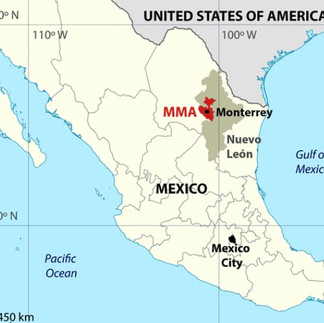





























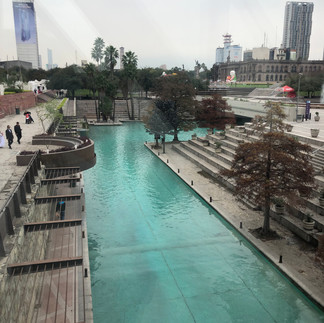









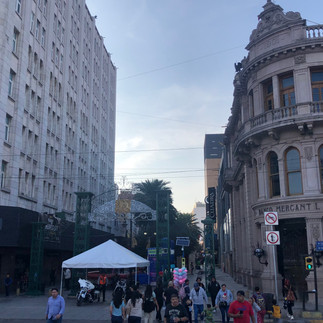








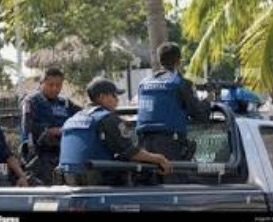





































































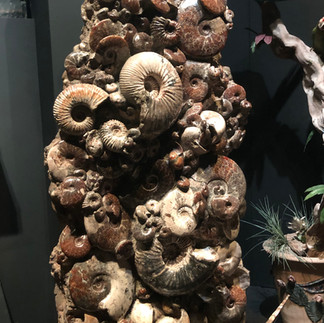











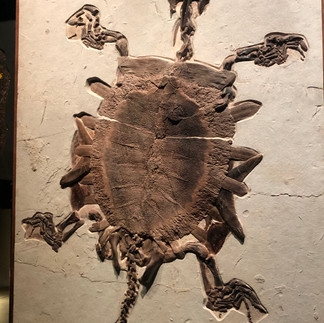

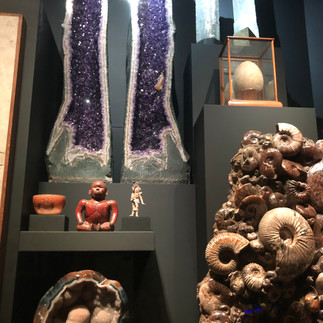













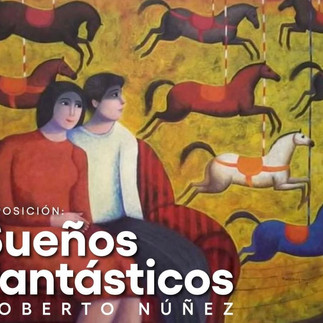




Comments